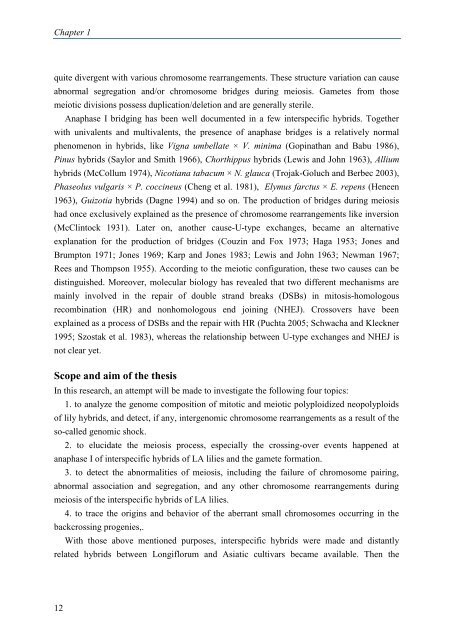A molecular cytogenetic analysis of chromosome behavior in Lilium ...
A molecular cytogenetic analysis of chromosome behavior in Lilium ...
A molecular cytogenetic analysis of chromosome behavior in Lilium ...
You also want an ePaper? Increase the reach of your titles
YUMPU automatically turns print PDFs into web optimized ePapers that Google loves.
Chapter 1quite divergent with various <strong>chromosome</strong> rearrangements. These structure variation can causeabnormal segregation and/or <strong>chromosome</strong> bridges dur<strong>in</strong>g meiosis. Gametes from thosemeiotic divisions possess duplication/deletion and are generally sterile.Anaphase I bridg<strong>in</strong>g has been well documented <strong>in</strong> a few <strong>in</strong>terspecific hybrids. Togetherwith univalents and multivalents, the presence <strong>of</strong> anaphase bridges is a relatively normalphenomenon <strong>in</strong> hybrids, like Vigna umbellate × V. m<strong>in</strong>ima (Gop<strong>in</strong>athan and Babu 1986),P<strong>in</strong>us hybrids (Saylor and Smith 1966), Chorthippus hybrids (Lewis and John 1963), Alliumhybrids (McCollum 1974), Nicotiana tabacum × N. glauca (Trojak-Goluch and Berbec 2003),Phaseolus vulgaris × P. cocc<strong>in</strong>eus (Cheng et al. 1981), Elymus farctus × E. repens (Heneen1963), Guizotia hybrids (Dagne 1994) and so on. The production <strong>of</strong> bridges dur<strong>in</strong>g meiosishad once exclusively expla<strong>in</strong>ed as the presence <strong>of</strong> <strong>chromosome</strong> rearrangements like <strong>in</strong>version(McCl<strong>in</strong>tock 1931). Later on, another cause-U-type exchanges, became an alternativeexplanation for the production <strong>of</strong> bridges (Couz<strong>in</strong> and Fox 1973; Haga 1953; Jones andBrumpton 1971; Jones 1969; Karp and Jones 1983; Lewis and John 1963; Newman 1967;Rees and Thompson 1955). Accord<strong>in</strong>g to the meiotic configuration, these two causes can bedist<strong>in</strong>guished. Moreover, <strong>molecular</strong> biology has revealed that two different mechanisms arema<strong>in</strong>ly <strong>in</strong>volved <strong>in</strong> the repair <strong>of</strong> double strand breaks (DSBs) <strong>in</strong> mitosis-homologousrecomb<strong>in</strong>ation (HR) and nonhomologous end jo<strong>in</strong><strong>in</strong>g (NHEJ). Crossovers have beenexpla<strong>in</strong>ed as a process <strong>of</strong> DSBs and the repair with HR (Puchta 2005; Schwacha and Kleckner1995; Szostak et al. 1983), whereas the relationship between U-type exchanges and NHEJ isnot clear yet.Scope and aim <strong>of</strong> the thesisIn this research, an attempt will be made to <strong>in</strong>vestigate the follow<strong>in</strong>g four topics:1. to analyze the genome composition <strong>of</strong> mitotic and meiotic polyploidized neopolyploids<strong>of</strong> lily hybrids, and detect, if any, <strong>in</strong>tergenomic <strong>chromosome</strong> rearrangements as a result <strong>of</strong> theso-called genomic shock.2. to elucidate the meiosis process, especially the cross<strong>in</strong>g-over events happened atanaphase I <strong>of</strong> <strong>in</strong>terspecific hybrids <strong>of</strong> LA lilies and the gamete formation.3. to detect the abnormalities <strong>of</strong> meiosis, <strong>in</strong>clud<strong>in</strong>g the failure <strong>of</strong> <strong>chromosome</strong> pair<strong>in</strong>g,abnormal association and segregation, and any other <strong>chromosome</strong> rearrangements dur<strong>in</strong>gmeiosis <strong>of</strong> the <strong>in</strong>terspecific hybrids <strong>of</strong> LA lilies.4. to trace the orig<strong>in</strong>s and <strong>behavior</strong> <strong>of</strong> the aberrant small <strong>chromosome</strong>s occurr<strong>in</strong>g <strong>in</strong> thebackcross<strong>in</strong>g progenies,.With those above mentioned purposes, <strong>in</strong>terspecific hybrids were made and distantlyrelated hybrids between Longiflorum and Asiatic cultivars became available. Then the12














